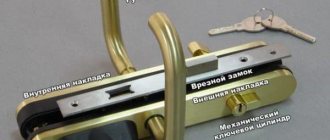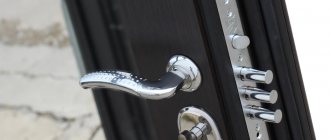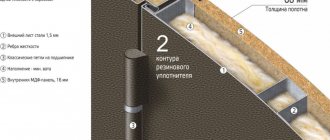To ensure that the door lock does not jam at the most inopportune moment, the mechanism must carry out periodic maintenance. Lubrication plays a key role in this process. Next, we will try to figure out which lubricant for entrance door locks is used in a given situation and how to properly lubricate the lock.
Not every type of lubricant is suitable for locks on entrance doors
When is it necessary to treat a lock?
Almost half of our compatriots think about how to lubricate the door lock of the front door only after this lock begins to jam or make unnatural sounds when closing. But people do not take into account that at this moment lubrication does not always help, because the lock already requires repair.
Lubricant for entrance door locks should be in every home, and in order not to one day find yourself locked in your own home, all locking mechanisms must be periodically lubricated. The time for maintenance work depends on where the doors are installed.
- Locks on entrance doors that are in direct contact with the street experience the heaviest load. Seasonal and sometimes quite sharp temperature changes cause condensation to settle, and dust is blown through the keyhole by the wind. To avoid problems, such locks need to be lubricated at least once a quarter;
- The apartment doors are located in the entrance and this provides them with some security. Heated entrances are rare in our country, so condensation is also present in these locks, but there is much less dust in the entrance. Under these conditions, prophylaxis is carried out once every 6–8 months;
- Door locks installed in heated rooms, for example, on office entrance doors, are lubricated once a year.
Locking mechanisms on street entrance doors must be lubricated at least once every 4 months
Causes and consequences
Dust gets into it through the lock cylinder.
- These smallest fractions act on all elements of the mechanism as an abrasive. The result is their increased wear; and this process is avalanche-like. The metal particles (chips) themselves begin to have an identical effect on the lock.
- Changes in the geometry of parts due to abrasion lead to incorrect operation of the lock, expressed in the key slipping, incomplete release of the tongue (bolts) from the body, and so on.
- Dust, collecting in lumps, can block the free movement of parts of the lock mechanism.
Rust
It cannot be avoided on metal, especially if it is an entrance door or installed in an opening leading to a room with excess humidity and temperature changes; The appearance of condensation inside the lock is guaranteed. The effect is almost the same as that of dust; but with deeper consequences - the gradual destruction of “hardware”. And this reduces both the durability and strength of the bolt.
Poor sliding of moving parts
No detailed comment is needed here. If you do not regularly lubricate the mechanism, then pretty soon problems will arise with it - tight turning of the key, jamming of the cylinder, limited movement of the bolts, and the like.
Choice of product
With the current abundance of oils and various types of lubricants, the question of how to lubricate a door lock becomes a problem for the uninitiated person. The most popular ones include the following:
- Machine oil – in common parlance this oil is also called “spindle”. The price of such oil is low; it is sold in oil cans with a built-in pipette and is intended for lubricating household mechanisms. The product is good, but the spindle is quickly washed off and tends to attract dust;
- Silicone lubricant for door locks is considered one of the most modern and high-quality types of lubricant. Specialized silicone compounds can be used for any type of lock, including car and street locks;
Locks are lubricated with traditional types of lubricant
- Graphite grease is nothing more than pure graphite powder. This powder is sold in the store, but if there is no store nearby, you can erase the graphite rod of a simple pencil with sandpaper or a file;
- WD-40 is an excellent modern product that is available in more than 10 types of packaging. As for locks, spray cans with a removable tube for spot application are best;
The universal WD-40 product has many types of packaging
- Calcium grease - better known as grease. The high quality of this lubricant has been proven by many years of use, but the composition itself has a viscous, thick consistency, which creates problems when putting grease into the lock mechanism;
- Lithium grease or litol - intended for lubricating bearings, but lithol is also suitable for locks. As for the disadvantages, litol is similar in consistency to grease, so for high-quality, complete lubrication, the lock must be disassembled;
- Gun oil is an excellent all-purpose product that is completely suitable for locks. Gun lubricant does not freeze at low temperatures and protects metal well from corrosion, although its price is higher than that of ordinary machine oil;
- Carbon lubricant - in essence, carbon lubricant is the same graphite dust, only on a liquid basis. This composition is easier to apply to certain points and nodes of the lock;
For locks, it is better to take gun oil in an aerosol can.
Dependence of choice on the type of lock
The range of door locks is quite large, and accordingly, the lubricant used for door locks is different in each specific case. By the way, you can learn in detail about the types of locks for entrance and other doors “ZZ IS” .
- So, for locks with a cylindrical cylinder of the English type, liquid compounds such as machine oil, WD-40 or silicone grease are more suitable;
- Crossbar locks are also lubricated with liquid compounds;
- Lever locks have a wide keyhole, so a lot of dust enters the mechanism through it. In this case, the best option would be carbon lubricant or graphite powder;
- Outdoor padlocks are traditionally lubricated with machine oil.
If you find it difficult to choose a lubricant for the lock, then take a silicone compound. The price of silicone lubricants is higher, but they are universal and suitable for all locking mechanisms.
Specialized silicone lubricants are considered universal
What is the best way to lubricate car door hinges for the winter?
What should you do if your car door hinges squeak and jam, how to lubricate them? In principle, there are quite a few special tools for carrying out this service maneuver, but we will consider the most popular ones. We’ll start with the question of what lubricant to lubricate car door hinges with the criteria that this same lubricant should meet:
- sufficient penetrating properties;
- long-term lubricating effect;
- the widest possible range of operating temperature conditions;
- anti-corrosion abilities;
- maximum reduction in friction coefficient;
- optimal combination of price and quality.
Well, in addition, the lubricant composition must have a normal consistency. That is, it should not be thick in order to have good penetrating abilities and too liquid, otherwise the interior of the car along with the body can become very dirty, and getting rid of these troubles will not be easy! So, the products that are especially popular among car enthusiasts: Liqui Moly Wartungs-Spray Weiss
This composition is white in color and contains microceramics in its structure. Lubricating properties are simply excellent. The surface treated with this product acquires water-repellent properties, and also increases protection against corrosion. After applying the lubricant, the car owner can count on long-term protection from dirt deposits and a reduced degree of friction of the elements in contact with each other. The spray is intended for locks, hinges and other moving mechanisms. The composition can be used in the following temperature conditions: from -30 to +250 degrees Celsius. Wurth HHS 2000
What's best to use
In the previous chapter, we outlined how to lubricate the front door lock, but choosing a specific composition is a delicate matter and there are several more nuances here.
So few manufacturers indicate that graphite-based lubricant is easily washed off with water, so for street doors with a lever lock there are 2 options. Either add graphite powder every couple of months, or buy a silicone water-repellent compound and lubricate the lock once every six months.
On the Internet, some home-grown craftsmen advise lubricating the front door lock with sunflower oil or animal fat. So, it is absolutely forbidden to do this, firstly, these compounds strongly attract dust, and secondly, with temperature changes and frost they quickly thicken, all this leads to the fact that within 3 - 4 months the lock can jam.
There are also tips on using waste machine oils to lubricate door locks. We do not recommend that you do this, the fact is that waste engine oil is literally stuffed with a suspension of metal dust and other slags, which begin to crystallize when temperature changes occur. Essentially, you are pouring dirt into your castle with your own hands.
Advertising positions WD-40 as a universal lubricant, although this is not entirely true. The composition is really high quality and very good, but it is more suitable for emergency cleaning of the mechanism from rust and other radical contaminants. And after WD-40 has removed all the dirt from the mechanism, it is necessary to apply a narrow-profile lubricant for a specific type of lock.
How to properly lubricate a lock
Lubrication of the lock is carried out in several stages, and the first thing it is advisable to start with is cleaning the mechanism. Silicone compounds are a good thing, but if there is already a problem with closing, silicone lubricant for door locks will not correct the situation; WD-40 is needed here.
Lubricant is poured into all accessible points of the lock
Before lubricating, it is advisable to remove all decorative trims and door handles; they will interfere with work.
When the lock acts up, ideally it is better to remove it, then disassemble it, clean it and lubricate it. But if you are too lazy to do all this, then take WD-40 and pour it generously into all accessible holes of the lock. The composition removes rust and other deposits in 30 - 40 minutes, so after filling with WD-40, leave the lock alone.
Next, insert the key into the hole and open and close the mechanism 5–7 times; if the problem goes away, then fill in the profile lubricant. If the squeaks continue, then repeat washing with WD-40, and then add lubricant. The composition is poured into several points:
- Keyhole;
- The entry point of the rotary door handle, if any;
- Locking bolts and tongues on the ends of the doors.
When lubricating a cylinder-type lock, it is necessary to remove the cylinder head and lubricate the lock mechanism and the head separately.
It is advisable to remove the lock cylinder before lubrication.
How to lubricate car doors: hinge lubricant
Taking into account the fact that the car is operated in an aggressive environment, corrosion, oxidation, destruction of rubber seals, etc. are inevitable over time. Also, quite often on cars even with low mileage, creaking doors appear.











